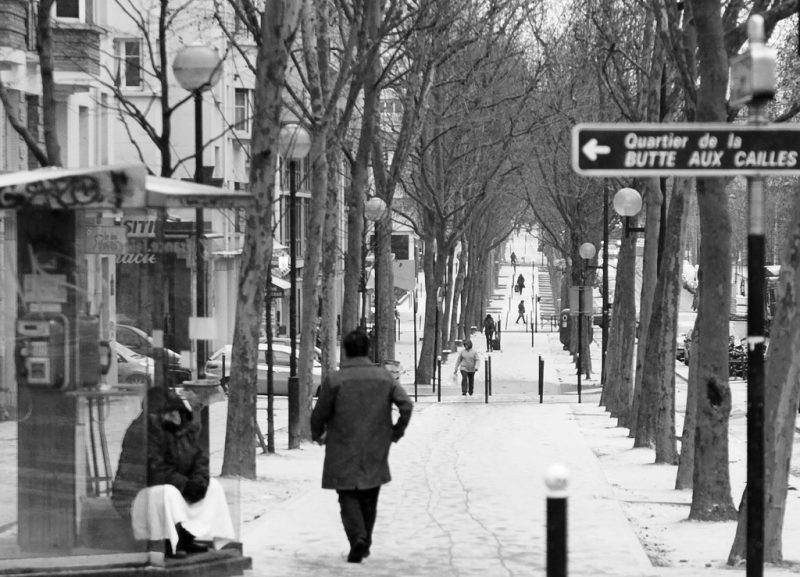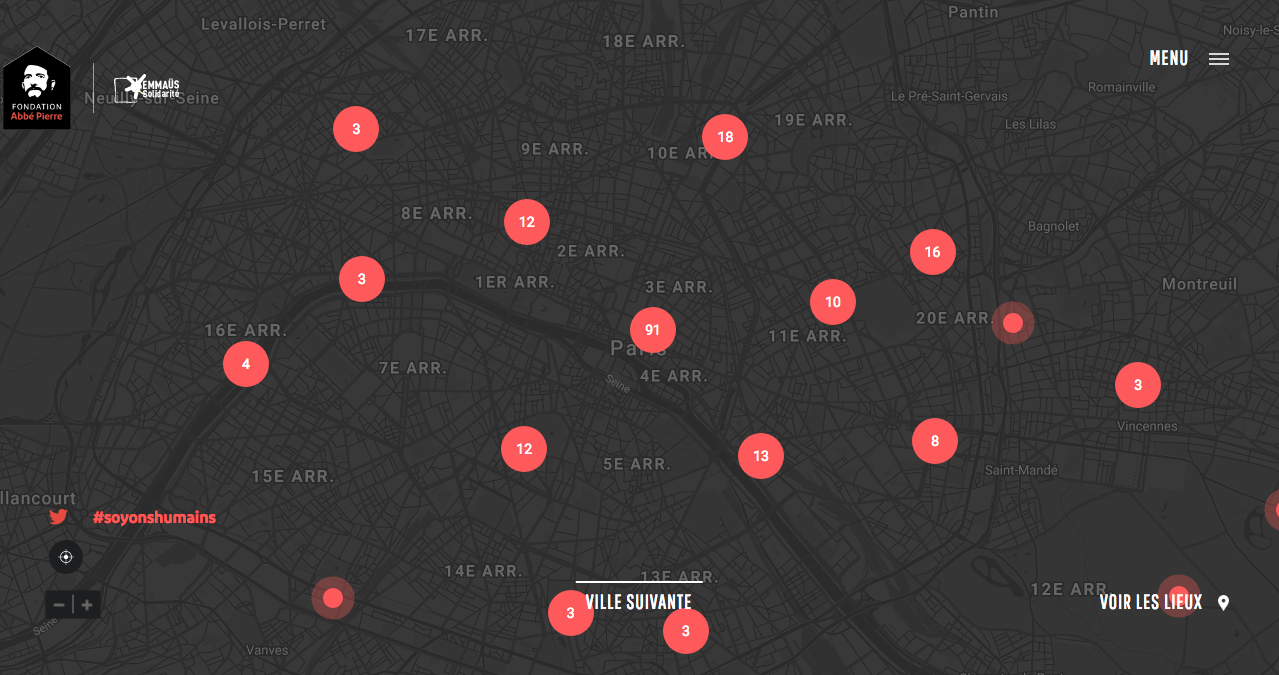
A man passes a homeless person sheltering in a phone box, in a snowbound Parisian street. Photo by Gustave Deghilage, published on Flickr under licence CC BY-NC-ND 2.0
While European media has been having a field day bestowing poetic epithets on the cold wave which has affected the continent for several days — “Moscow-Paris” in France, the “Beast From The East” in the United Kingdom, or the “Siberian Bear” in the Netherlands — the situation of the homeless is fast becoming an emergency.
Since the 1 January 2018, the collective Deaths on the Street has logged almost 70 “persons of no fixed abode” (“sans domicile fixe”, or “SDF”, in French) across France who have died, over a dozen of them in Paris.
No official estimate of the number of homeless people currently exists in France. For Florent Gueguen, the director general of the Federation for Solidarity Actions (Fédération des acteurs de la solidarité), “France is lagging behind on the question“. The last examination by the National Institute for Statistics and Economic Studies (INSEE), which goes back to 2012, concluded there were 142,000 homeless people, a figure which, on top of being dated and partial, does not specifically count rough sleepers.
Even in the absence of reliable figures, the issue of homeless people resurfaces in the French media each winter. Every year without exception, as soon as the temperatures tumble, reports on the homeless facing the cold weather start to appear, just like stories about traffic jams on the holiday routes in August or the return to school in September.
In 2018, however, the coverage of the difficulties encountered by homeless people has intensified, both in traditional media and on social media, owing to a series of declarations made for the first time by the government of political party La République en Marche (The Republic Moving Forward).
Addressing the French people on the evening of 31 December 2017 with his official New Year's Resolutions, President Emmanuel Macron in effect assured them of his commitment to housing rights:
Je veux que nous puissions apporter un toit à toutes celles et ceux qui sont aujourd'hui sans-abri. Le gouvernement s'est beaucoup engagé dans cette direction ces derniers mois et a beaucoup amélioré les choses, mais il y a encore des situations qui ne sont pas acceptables.
I want to see us able to put a roof over the heads of all those who are homeless today. The government has greatly committed itself in this direction over the last few months, and has greatly improved things, but there are still situations which are unacceptable.
Macron was reiterating a promise expressed in a speech at Orléans on 27 July 2017:
La première bataille : c’est de loger tout le monde dignement. Je ne veux plus d’ici la fin de l’année avoir des femmes et des hommes dans les rues.
The first battle is to house everyone fittingly. I don't want in a year from now for there to be women and men on our streets.
After the New Year's Resolutions speech, advocates and voluntary organizations immediately decried Macron's unrealistic promise, which would be impossible to keep in the light of the means currently accorded to the struggle for housing rights. In response, government spokesperson Christophe Castaner stuck to his guns, justifying the failure to realize this objective, in an interview on BFM TV on 29 December 2017:
Promesse de Macron pour les sans-abris: “Des femmes et des hommes, dans le cadre des maraudes, refusent aussi d'être logés” selon Castaner pic.twitter.com/jen1HznygA
— BFMTV (@BFMTV) 29 décembre 2017
Macron's promise to the homeless: “Women and men, in the tradition of the maraud, are refusing to be housed,” says Castaner.
On social media, people were quick to react to a statement seemingly placing the blame on homeless people:
Les propos de Castaner sont inappropriés et déplacés, sincèrement qui veut vivre dans la rue dans des conditions aussi difficiles ? La question a se poser est de savoir comment se passe l'accueil et le traitements des SDF dans les structures d'accueil…#GGRMC
— Jacques Solay (@keja_solay) 2 janvier 2018
Castaner's remarks are inappropriate and misplaced. Who really wants to live on the streets in such difficult conditions? The question we should be asking is what reception and treatment are the homeless getting on admission…
Deux heures de maraude et une heure au 115 suffiront, M. @CCastaner, pour prendre la mesure de l’indécence de votre affirmation. Merci de ne pas ajouter à la souffrance des personnes sans-abris une propagande niant leur combat quotidien pour rechercher un hébergement pérenne. https://t.co/p8FmlrEm8d
— Bernard Thibaud (@bthibaudsc) 29 décembre 2017
Two hours on the maraud, and one hour on the 115 (emergency housing helpline) are all it takes, Mr. @CCastaner, to gauge your shamelessness in making that remark. Please don't add to the suffering of homeless people by denying their daily struggle to find sustainable accommodation for the sake of propaganda.
Ça suffit, maintenant. Ce n'est parce que certains SDF refusent qu'on les jette dans des hangars inqualifiables d'absence d'hygiène et de violence permanente qu'il faut expliquer par ces cas marginaux l'absence de prise en compte d'une urgence considérable. Un peu de dignité, svp https://t.co/uBnKns93zj
— FondationAbbéPierre (@Abbe_Pierre) 31 décembre 2017
Enough, now! It's not the refusal of some homeless people to be thrown into unspeakable hangars, where there's an absence of hygiene and permanent violence, which explains, from such marginal cases, your failure to get a grip on a substantial emergency. A little dignity, please! https://t.co/uBnKns93zj
In November 2017, an article in Catholic newspaper La Croix revealed that only 25% of emergency housing applications were successful in the Parisian region. A tally which varies between 6 and 39% in the other regions of France according to the Federation for Acts of Solidarity.
Furthermore, the squalid state of many accommodation centres is equally to blame: toilet facilities out of order, mould, leaks… For many homeless, the street is still a preferable solution to the reception centres. Some are upset that certain facilities refuse to accept dogs. Others point to the violence that can break out inside the centres some nights. Homeless women don't always feel safe in them.
‘Let's Be Human': A call to solidarity on social networks
And yet, living conditions on the street are tough. On top of the cold, the hunger, the invisibility, the the homeless must contend with the adaptations of French inner cities that are meant to keep out a poverty residents don't want to see.
In December 2017, the Abbé Pierre Foundation and Emmaus Solidarity launched a public awareness campaign on social networks entitled #SoyonsHumains (Let's Be Human). Encouraging users to protest against the proliferation of “hostile design” street furniture, the campaign has been followed by thousands of Twitter users nationwide.
#SoyonsHumains Dispositif anti-SDF devant une banque parisienne… @thierry_kuhn @emmaus_france @FSivignon @JoelWeilerMdM @NathGodard_93 @pimpollito8 pic.twitter.com/LzzOisvLEM
— François Berdougo (@FBerdougo) 7 février 2018
#SoyonsHumains Anti-rough sleeper measures in front of a Paris bank…
Est-ce bien nécessaire ? ? #soyonshumains au 54 rue de la Roquette pic.twitter.com/nKhSnTEebu
— SMB (@_StephMB_) 7 février 2018
Is this really necessary? ? #soyonshumains au 54 rue de la Roquette
#soyonshumains la copro du 76 rue Bobillot #paris #notmyparis pic.twitter.com/ypnDGEpcsX
— Cécile Bénoliel (@CecileBenoliel) 1 février 2018
#soyonshumains apartment building 76 rue Bobillot #paris #notmyparis
Dispositif anti-sdf bravo @LCL #soyonshumains 7 rue Jourdain à Paris pic.twitter.com/dOgMMX0gmH
— Fanny Lepoivre (@FannyLepoivre) 27 janvier 2018
Anti-rough sleeper measures – well done @LCL! #soyonshumains 7 rue Jourdain in Paris
Bon ben là, Il y a 2 solutions?
Soit la ville de @Paris veux installer des cages à tigres?
Soit c'est pour empêcher “des gens” de s'abriter de la pluie☔☔☔
Entre le 99/101 avenue de St Mandé 75012. Sous le pont de l'ancienne petite ceinture ?#soyonshumains @Abbe_Pierre pic.twitter.com/rQ00uRcEmx
— Page (@Pagechris75) 21 janvier 2018
OK there are 2 solutions here ?
Either the city of @Paris is trying to erect tiger cages?
Or this is to stop “people” sheltering from the rain☔☔☔
Between 99 & 101 avenue de St Mandé 75012. Under the former goods railway bridge ?#soyonshumains
Three months later, #SoyonsHumains has been able to plot more than 250 hostile design features on an interactive map, constantly updated.

Mapping of hostile design street furniture in Paris, created by the Fondation Abbé Pierre and Emmaüs Solidarité from data submitted by online users. Screen capture from the site SoyonsHumains.fr
In furtherance of this campaign, Christian Page, “Rough Sleeper 2.0″ who has been on the street for two years according to his profile, published a photo on Christmas Day protesting against the presence of barriers round hot air vents customarily used by the homeless to warm themselves:
Salut à tous ?
Rue de Meaux 75019
Grilles d'air chaud ou parfois se posaient les #SDF. Sauf que maintenant voilà ???#soyonshumains @Abbe_PierreSinon venez cet aprèm’ à 15h M° Varennes avec le DAL… Histoire de se faire entendre ? @federationdal
Joyeux Noël ??? pic.twitter.com/DRSAMBmQzb
— Page (@Pagechris75) 25 décembre 2017
Hi all ?
Rue de Meaux, 19th arrondissement
Hot air vents where persons of no fixed abode used to gather. Except now look at them! ???#soyonshumains@Abbe_Pierre
Alternatively, turn up this afternoon at 3 at Varennes metro station with DAL [Housing Rights organization]… Histoire de se faire entendre ?@federationdal
Happy Christmas ???
The photo, re-tweeted more than 2,000 times, got the attention of Paris Mayor Anne Hidalgo, who had the obstacle removed two days later:
Paris : un dispositif anti-SDF retiré grâce à un tweet | https://t.co/K6YkmlFfIe #Paris #soyonshumains pic.twitter.com/ypAjVTT4oo
— France 3 Paris (@France3Paris) 27 décembre 2017
A small victory for Page, who has been relating the daily lives of homeless people in Paris for more than two years, “the good stuff with the shit stuff”:
Salut à tous ?
Je suis #SDF mais je suis aussi un être humain et un citoyen à part entière. Avec des devoirs, certes, mais avec des droits aussi?
J'ai le droit de dénoncer des situations qui me semblent abjectes?
C'est notre forme de liberté ???
Bonne journée ??? https://t.co/YsAVJJu61t
— Page (@Pagechris75) 29 décembre 2017
Hi all ?
I'm #SDF [no fixed abode] but I'm also a human being and full citizen. With duties, I grant you, but with rights too?I have the right to protest about situations which disgust me ?
It's our form of liberty???
Have a great day ???
No official homelessness figures in France
On 21 February 2018, First Deputy Mayor of Paris Bruno Julliard unveiled the results of a previously unpublished census of rough sleepers in Paris, carried out from 15 to 16 February. During the Night of Solidarity, organized by social and voluntary workers, there were nearly 3,000 people categorized as homeless, despite the particularly icy temperatures for a February.
While a “Big Cold” plan has been adopted by the French authorities in 68 local government areas, the debate over housing rights and the situation of the homeless in French cities has raged across social networks. Perhaps at last an opportunity has opened up for citizens to demand that the local and national political powers adopt serious measures for the admission and rehabilitation of and solidarity with homeless people in France.






